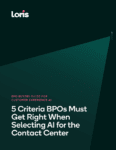

The customer service business process outsourcing (BPO) industry has been a key partner in helping brands streamline their operations and provide top-notch support to their customers. This has been an especially critical role as businesses need to scale or add capacity quickly, whether due to newfound popularity or seasonal spikes. But the explosion of interest in and adoption of AI over the last two years has called into question their fundamental business model.
Specifically, it has raised an existential question: “can BPOs balance the competing priorities of making money charging per agent while simultaneously embracing automation to reduce the need for human agents?” In this blog, we will delve into these challenges and explore how BPOs can harness the power of AI and automation to adapt their business models and stay ahead of this existential threat.
The BPO Automation Dilemma
The majority of BPOs charge their clients based on the number of agents assigned to handle their tasks. This model works well when human agents are the primary workforce responsible for customer service and other processes. However, as artificial intelligence and automation technologies remove low level tasks, businesses are increasingly looking to reduce costs and enhance efficiency by automating routine tasks.
Automation, powered by AI, can handle a wide range of tasks, including data entry, basic customer inquiries, and even some forms of troubleshooting. This reduces the need for a large workforce of human agents, making the traditional per-agent pricing model less attractive to clients. It’s a dilemma for BPOs because they must find ways to remain competitive while adjusting to this shift in client expectations.
Top three challenges in the BPO industry
To simplify what’s happening, these are the main obstacles BPOs are dealing with today, and each of them are significant.
- Pricing pressure: If the traditional business model of BPOs has been charging for human capital, the main point of comparison was mainly price. This is what led to the boom in outsourcing call centers in the last two decades; if BPOs can provide agents at a lower price, the BPO is the obvious choice. This uncovered a trade-off between price and quality, but while offshore quality improved, the price could only go so low.
Now BPO clients are seeing all the potential of AI and automation leading them to demand more cost-effective solutions. This puts pressure on BPOs to either invest in more technology, reduce their prices, or both. Obviously, this would result in squeezed profit margins, but it also presents potential difficulties in keeping up with ever-changing technology trends.
- Competition: As stated above, the traditional BPO model traded on a mix of price and quality. And because switching costs are low, brand clients can easily move from one BPO to another if the perception is that the offering is the same. To stand out, BPOs differentiate on quality, but measuring quality can be subjective. Many BPOs added additional offerings like management of CRM or other customer service technology, consultative services, or even specialization for certain industries to create differentiation.
Now, new technology entrants like virtual agents and chatbots are taking business away from BPOs by offering to do some of the same jobs as human agents. This means BPOs are facing competition from both within the industry and outside, leading to a race to the bottom if competing on price.
- Shifts in workforce and market: The transition from a human agent-centric model to an automated one requires significant changes in staffing, training, and skill development. Retaining and reskilling the existing workforce can be a challenge. Not to mention, this requires a rethinking of what exactly the BPO delivers if not based on per agent headcount. The easy answer is to charge based on outcome or “value”, but both of those require the BPO to have a complete picture of all customer activity and an agreement on the value provided. In addition, BPOs would have to assume the risk of staffing without already knowing if the headcount is accounted for.
Adapting the BPO business model to the Automation Era
To overcome these challenges and evolve with the changing landscape, BPOs can leverage AI and automation in several ways:
- Using AI to superpower agents: Rather than seeing automation as a threat, BPOs should view it as an opportunity for empowering their teams. By integrating AI tools with human agents, companies can enhance their efficiency and provide more personalized and efficient customer service without sacrificing quality. This combination of human expertise and AI capabilities can create a compelling value proposition for clients and keep BPOs in a position where they are a critical piece of the customer experience for brands.
- Upskilling and reskilling: In order for the above strategy to work, BPOs cannot sit on the sidelines. They should invest in training and upskilling their workforce to become proficient in working alongside AI systems. This doesn’t mean each BPO needs a small army of data scientists. But creating new roles or training existing staff to make better use of AI will pay dividends.
- Embrace process automation: BPOs can use automation to streamline their internal processes, reducing operational costs. By automating administrative tasks, they can allocate resources more effectively and improve overall productivity. Increased automation and efficiency also means agents can take on more complex tasks, such as handling escalated customer issues, managing AI systems, and analyzing data to provide insights for continuous improvement.
- Use AI to be their CX expert: Implementing advanced analytics and AI-driven insights can help BPOs identify areas for improvement, provide proactive solutions, and predict customer needs. This data-driven approach can lead to better decision-making and higher customer satisfaction. It also shifts BPOs to the position of AI-powered consultant instead of outsourced labor, giving greater value to the client that’s harder to replace.
- Outcome or interaction-based pricing: Transitioning away from the cost per headcount model is a major shift. Some BPOs are already discussing changing to an interaction based model, whereby they charge brand clients based on the number of human and chatbot interactions. As mentioned above, outcome-based can be difficult for activity performed outside of the contact center, but for use cases like sales or retention that can align BPOs with the goals of their clients. Either model encourages BPOs to optimize their processes and leverage automation to achieve shared success.
Where do BPOs go from here?
The customer service outsourcing and BPO industry must confront this change – and do so now. The traditional per-agent pricing model won’t go away tomorrow, next month, or even next year, but the shift to automation and AI is already happening. BPOs have a window of time to adapt and thrive by embracing AI and automation as enablers rather than threats. By empowering their workforce, upskilling employees, and leveraging automation intelligently, BPOs can provide value-driven services that cater to the evolving needs of their clients, ensuring their relevance and central role in customer experience.
Ready to take the first steps toward an AI-powered contact center? Download our BPO Buyer’s Guide for AI in the Contact Center to make the right choice for your business and your clients.
Image courtesy of DALL-E
Prompt: picture that conveys the idea of a dilemma, specifically showing a professional trying to decide whether to continue with a traditional approach or embrace AI



